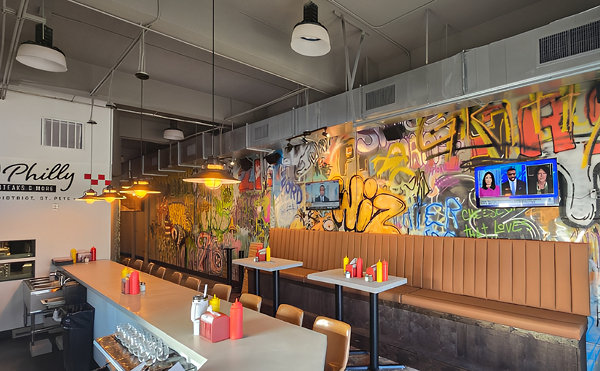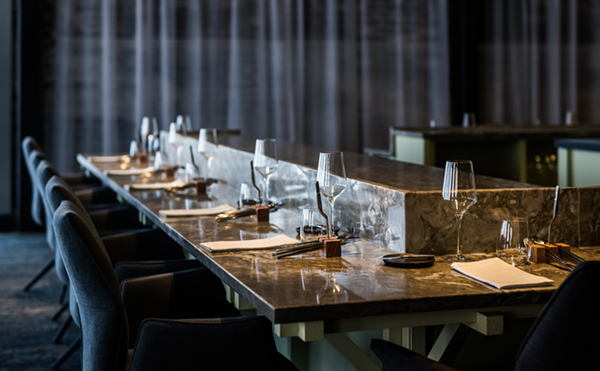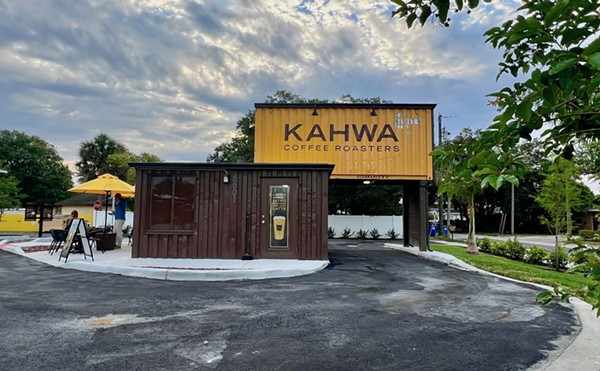[image-1]In the old days, families went to Palmetto Beach to catch blue crabs using only some line, a net and a chicken neck as bait. Some crabs would be boiled right there on the beach, the rest brought home for the chilau feast. With such a ready harvest of crabs, chilau quickly became a Tampa backyard favorite, shared among family and friends who would gather around newspaper-covered picnic tables, armored in painting clothes to catch the tomato sauce that splattered with every crack of a crab shell. As the lazy afternoons stretched past sunset, all traces of sauce and crab on the plates were sopped up with crusty Cuban bread.
Tampa’s African-Americans were deeply devoted to chilau as a festive and collective dish. In an interview for the USF Libraries Oral History Program, educator and WMNF DJ Otis Anthony, 59, recalled his family’s West Tampa chilau ritual of the 1950s and 60s.
We had huge buckets of ice, buckets of watermelon, and we would skin catfish with pliers, and we would have little knives to eat our sugarcane stalks with. Of course, the center meal for every get-together, believe-it-or-not it wasn’t pork. It was crab chilau and if you had crab chilau, you know everybody on the block come by your house because they [could] smell it cooking two miles down the road. It was blue crabs, none of this stuff we buy at Publix and Winn-Dixie today. It’s a kind of Cuban-African-American way of doing this sauce. It’s highly seasoned with onions and garlic and bell pepper and God knows what else. You slightly boil the crabs then you cook them further in the crab chilau before you serve it, and it’s really good across a plate of spaghetti. And, of course, buttered Cuban bread. It was heaven!
When I grew up, on a Friday and Saturday night, up until four or five o’clock in the morning, we didn’t close the back door or the front door. We had screen doors and people flowed in and out and that was just a very natural way of living. And, if you wanted to come in and sit down, have a drink, have a laugh, and eat some crabs, you were welcome to whatever we had left in the pot. And it was that way with everybody in that neighborhood.
The scarcity of blue crabs and a ban on beach cooking have made chilau rituals a thing of the past. Today, pollution in the Gulf of Mexico has eroded the blue crab population, making the big backyard boils an expensive and rare occurrence.
[dataBox]
I had a backyard chilau feast recently to try my hand at making the dish. Using the Seabreeze By The Bay recipe as a starting point, I added a few flourishes of my own to enhance the flavor. With a few sacrifices along the way you can conjure some local culinary history and re-create the Tampa classic, too.
Remember, it’s not just a recipe, it’s an event.
Crab Chilau
1/4 cup olive oil
1 large onion, chopped
1 bell pepper, chopped
8-10 cloves garlic, minced
1 28-ounce can tomato puree
1 14-ounce can whole tomatoes, chopped
1 small can tomato paste
1 jalapeno pepper with seeds, minced
2 12-ounce beers, preferably light in flavor (think domestic, I use Busch)
16 ounces stock (chicken, vegetable or shrimp)
4 bay leaves
Salt and pepper to taste
1 teaspoon dry oregano
1 teaspoon dry basil
1 tablespoon Old Bay Seasoning
1 tablespoon sugar
1 pound crab meat or 12 cleaned, parboiled blue crabs
Optional garnishes: Grated Parmesan or romano cheese, hot sauce, fresh basil leaves, fresh lime juice
1. Saute onion and pepper for two minutes. Add garlic and saute until onions are tender. Add jalapeno and tomatoes and stir. Add beer, stock, bay leaves, oregano, dry basil, Old Bay and sugar. Bring to boil, then simmer for about two hours until thickened slightly.
2. Adjust salt, pepper, and spiciness to taste. Add parboiled crabs or crab meat. When I use crabmeat, I prefer a mix of claw meat and lump crab meat. The claw meat blends into the sauce while the lump meat remains distinct. If you’re using whole crabs, cut the crabs in half or quarters and crack the claws slightly.
3. Cook the crab through and serve immediately. Garnish optionally with cheese, sauce, basil, and/or lime juice to taste.
Introducing Tampa Bay Foodways
Interested in learning more about — and exploring — Tampa’s food culture? If you work in the food and/or restaurant industry, teach or write about cuisine, or are just obsessed with good food, the newly formed Tampa Bay Foodways may be the group for you. On May 22 join us for our inaugural event, a Cuban crab feast in Ybor. Eat, drink and prepare to get sloppy with a heaping plate of blue crab chilau and freshly rolled and fried devil crab prepared by the legendary Seabreeze Restaurant. Commiserate with your fellow food obsessives with a full cash bar, some crabby speakers (crabbers and crab scientists), and Latin jazz and salsa by Luna Jazz at the Marti-Maceo Club, Tampa’s historic Afro-Cuban immigrant society. Proceeds will go to the club’s restoration fund and Tampa Bay Foodways’ annual symposium in November.
$20 (if you RSVP by May 20), $30 at the door. 6 p.m., Saturday, May 22, Marti-Maceo Club, 1226 E 7th Ave., Tampa, tampabayfoodways.wordpress.com















